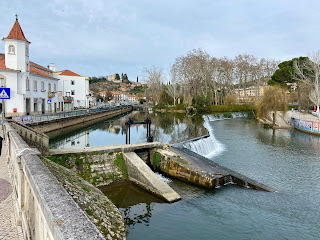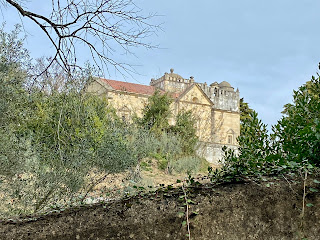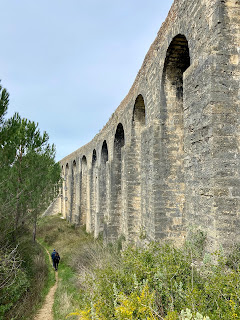We arrive in Sevilla on Día de Andalucía, February 28th, with news that Russia had fully invaded Ukraine. As we sit down for lunch, a parade marches down Avenida Menéndez y Pelayo, green and white flags headed for the Plaza de España. Our discussion as we consider autonomy, self-determination, and democracy.
ANDALUCÍA POR SÍ, PARA ESPAÑA Y LA HUMANIDAD [Andalusia by herself, for Spain and for Humankind]
After lunch, we search through the alleys for our accommodation. It's nearby, but down some backstreet. We pause as a black Lexus tries to squeeze-in where the street narrows. We hear awful noises. and we realize what those strange triangular wedges at the base of the building are for: they keep the cars off the masonry, like the sides of HotWheels tracks. Still, there are many 'exchanges' between car and building.
Exploring our new neighborhood, there are towers and churches on nearly every block. The color scheme is super-consistent: sandy tans, dirty reds, other earth-tones, and not much else. However, there are plenty of interesting shapes and silhouettes, and lots of marvelous ironwork and tile mosaics.
The colors remind us of the story of the Ukrainian flag, blue sky over a field of wheat. Once it's in our heads, the colors of the flag appear everywhere.
We pass through the Plaza del Cristo de Burgos and by the Iglesia de San Pedro – some beautiful architecture, a wonderfully shaded park, and just down the Calle Imagen, Las Setas.
Las Setas de Sevilla creates a novel and forceful disturbance in the urban fabric. We approach it from the Plaza de la Encarnación, near the Iglesia de la Anunciación (sixteenth century); seems ungracious to put this church in the shadows. But, with the holiday, the shops and restaurants are buzzing; the locals are loving it.
Across the Calle Imagen, there are stairs and escalators to the upper level. Only the tourists go up. We peer down on the activity within the older buildings all around.
We stop for a snack in the the Plaza Alameda de Hércules. Though the park itself is old, there are some angular, shady structures, about the same color as the Setas. Not sure how the old and new are supposed to 'blend', if they simply interrupt each other. In any case, it's not a very attractive park, but it s full of smiling people enjoying a warm day.
We reach the Rio Guadalquivir on the Puente de la Barqueta (1989-92). The Guadalquivir is smooth, creamy, and green. There are rowers and boaters gliding on the surface, and others fishing from the plaza. We stand in the shadows of one of the suspension arch beams, as the larger buses and trucks rumble by, the bridge trembles. On the other side of the river we can see a Disney-like collection of objects: a roller coaster, an angled tower (radio station), another tensile structure (a bridge? a ride? no, it's for flamenco), a series of thin steel frames hanging over the Pabellón del Futuro.
Further upstream we also see the Puente de Alamillo (1987-92) one of Santiago Calatrava's earliest bridge designs.
We turn around, and walking in the old city, and within a minute or two, are at the Muralla Almohade (twelfth century). The bridges, walls and gates don't just present the old and the new, they crash into each other in the oddest ways.
Perhaps the most captivating urban details are the tile memorials we find every so often. For example, we find one near the alley of Calle Antonio Susillo, in memory of a sculptor named Antonio Illanes Rodriguez, who passed away in 1976. And at the end of the alley is a glorious tile gateway, 'Maderas', under a tiled image of Nuestra Señora de la Esperanza.
On the way home we stroll by some quite large churches: Iglesia de San Luis de los Franceses (early eighteenth century), Iglesia de San Marcos (fourteenth century, with minaret-like bell tower), and Iglesia de Santa Catalina (thirteenth and fourteenth centuries), Convento de San Leandro (sixteenth century), Monasterio de la Visitacion de Maria de Salesas (nineteenth century).
Also, near our rooms, at the end of another alley, is a freshly-painted red facade with yellow trim – a drop of color in a sea of beige. Those are definitely the colors of the Spanish flag. This alley (Calle Lirio) is a shortcut for our new neighborhood to the north, and the facade quickly becomes a familiar landmark.
































































































